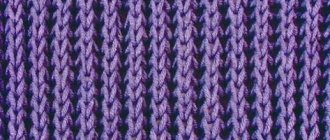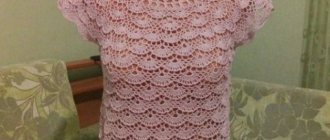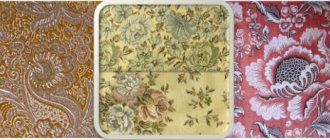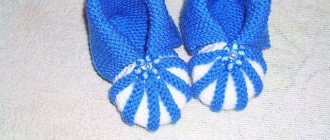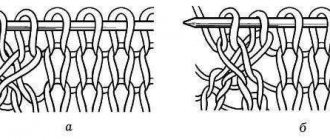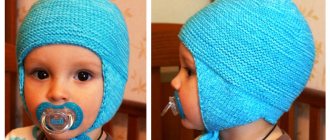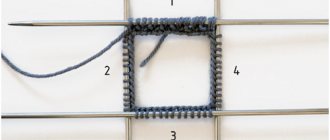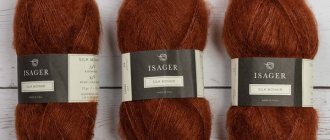Types of necklines in knitted items
Hand knitting in the modern world is a high-class skill. Having mastered the basic skills and techniques, a beginner can safely realize his creative potential. Among the key skills, a special place belongs to the ability to knit a neckline that matches the model.
The most common necks are the following:
- Round neck without trim, with single or double trim or open stand-up collar.
- V-neck with trim.
- Rectangular bob neckline.
- Boat neck with a straight edge or with edge processing using stocking stitch, elastic, openwork pattern and other methods.
The choice of neck depends on the model and style. It is necessary to strictly follow the recommendations in the description of the execution technique or calculate your own neck knitting scheme before starting the process.
Working with the necks of knitted items
Making the neckline, as the last stage of knitting, is intended to give the product the appearance of a finished piece. The methods of knitting a neck are very diverse, including knitting a neck from top to bottom, circular knitting a neck, and many others.
Therefore, you need to choose the form and type of execution at the sketching stage, based on the following factors:
- product type
- clothing style - classic assumes a round neckline, neckline - in the shape of the letter V. If there are folk motifs, the neckline should be in the shape of a square;
- seasonality of clothing - you can add an open neckline with a suitable type of trim to summer models; winter ones look better with a high stand-up neckline or trimmed with trim up to the neck;
- the age of the potential user - for example, knitting the neck of clothes for children and selecting a suitable shape implies convenience and requires fasteners (buttons or snakes).
Which necklines are best for women and men to wear?
For lightweight, summer knits for women, a boat neck is ideal. This is the simplest method that does not require much skill. The boat is suitable for both winter mohair dresses and sweaters, and for demi-season products made from warm thin yarn. This type of neckline perfectly emphasizes the femininity of the slight curve of the shoulder, placing emphasis on the line of the collarbones.
A round neck with a stand-up collar or a cowl collar is very common among the knitwear patterns of the world's leading designers. No fashion show is complete without presenting a model with a similar element. This collar will warm you on a cold winter day or protect you from the cold wind in the fall.
In men's jumpers made from wool yarn, the classic feature is a shallow round neck. This product is intended for lovers of a casual sporty style, and for adherents of the office style under a shirt and tie.
V-neck is a popular neckline among smart casual style lovers. The treatment and neck depth depend on the pattern and type of yarn chosen. This neckline makes the neck visually longer and the silhouette slimmer. Jumpers with a V-neck allow you to look presentable and quite democratic.
Loop calculation
In order for a knitted sweater or half-overshirt to look perfect, it is necessary to make accurate calculations, which are made on the basis of individual measurements.
Before you start knitting a product, it is recommended to create a pattern according to your measurements or have a finished product that is suitable in size. The first option is more preferable for beginners.
Loop calculations cannot be made without taking into account the knitting density, which depends on the thickness of the yarn, the thickness of the knitting needles and the individual knitting density of the craftswoman. To do this, knit a control sample and calculate the number of loops and rows in a 10x10 cm square after dry washing or after wet heat treatment of this sample.
Round neckline
How to knit a neckline with knitting needles for beginners is discussed step by step using the example of constructing calculations for a round neckline.
The knitting density is 17 loops per 28 rows.
- The neck width is 25 cm. It is necessary to calculate how many loops fit into 25 cm. To do this, you need to multiply 25 cm by 1.7 p. (the number of loops in 1 cm of the sample):
25 x 1.7 = 42 p.
How to knit a round neckline on a sweater
- 2 halves of the product are knitted separately: 42:2 = 21 p.
- The depth of the neckline is 7 cm. You should calculate how many rows you need to knit to close all the loops of the neckline: 7 x 2.8 = 20. So, it turns out 20 rows in the front and back rows. Consequently, the closure of the loops to form the neck occurs in 10 front rows.
- The bend for rounding the neck is conventionally divided into 4 sections: horizontal, flat, inclined and vertical. 21 items should be distributed among sections as follows:
21:4 = 5 stitches + 1 extra loop, which is better added to 1 section.
Thus, section 1 is 6 points, section 2 is 5 points, section 3 is 5 points, section 4 is 5 points.
- The loops in 1 section are closed all at the same time.
- The loops of section 2 should be cast off in 2 steps: cast off 3 sts, then cast off 2 sts.
- The loops of the 3rd section should be closed in 3 steps: close 2 stitches, then close 2 stitches, close 2 stitches (1 stitch from this section together with 1 stitch, which belongs to the 4th section)
- The loops of section 4 should be cast off in 4 steps: cast off 4 times, 1 stitch each.
The general pattern for knitting a round neck is as follows: you need to close: 1 time x 6 p., 1 time x 3 p., 4 times x 2 p., 4 times x 1 p.
The other half of the neckline is knitted in the same way.
V neckline
To create a V-neck, the number of front stitches must be odd. The fabric loops are divided in half, and the middle central loop is marked with a marker or closed. This is the center of the V-neck placket.
To form a uniform and beautiful bevel of the neck, it is necessary to calculate in which rows the loops should be closed. To do this, on the pattern you need to draw a line parallel to the bottom line through the bottom point of the cutout depth and lower the perpendicular from the extreme point of the shoulder bevel to the intersection with the line passing through the bottom point of the cutout.
The next step is to measure the horizontal distance from the cutout point to the intersection of the lines and calculate from the control sample how many loops “fit” in this segment (for example, 30 p.). This number of loops must be reduced to knit a cape-shaped neckline.
It is important to calculate at what distance to make decreases. To do this, measure the segment from the shoulder bevel to the intersection with the horizontal line. For example, this distance is 30 cm and divide this value by the number of loops that was determined earlier: 30 cm: 30 p. = 1 cm.
Based on the control sample or the edge loops in the knitted fabric, the number of rows in 1 cm is determined. For example, 4 rows in 1 cm. Therefore, decreases must be made in every 4 rows.
How to knit a neckline with knitting needles?
The shape of the neck depends on the model. In our example, after drawing construction lines (neck strip), the new neck line is located 2 cm below the main one, the upper edge of the strip ends above the base by 1 cm (this can be seen on the working pattern (Fig. 1).
Calculation of knitting shoulders and back neck
Knitting neckline for beginners, shoulders and back
Starting the calculation, connect the ends of the shoulders on the pattern with a straight line and lower the perpendiculars onto it, determining the width of the new neck. Next, do all the calculations on the right half of the pattern. Measure the width of the new neck (8 cm) and shoulder (12 cm) and determine the number of loops in these segments:
3 p. x 8 cm = 24 p. (half neckline);
3 p. x 12 cm = 36 p. (shoulder).
Measure the new slope of the shoulder (it is a little more than 3 cm) and, using the control sample, calculate the number of edges in this value, for example 7.
The number of edges in the shoulder slope always corresponds to the number of groups into which the shoulder loops need to be divided for decreases. Therefore, in this version there are 7 groups.
Now you need to find out how many loops are included in each group. To do this, the shoulder loops should be divided into the number of groups (or edge loops).
36 p.: 7 = 5 p. (1 p. left).
Add the remainder to the 1st group, counting from the end of the shoulder (if the remainder is greater than one, distribute it by 1 loop to each of the groups located at the end of the shoulder). So, on the shoulder you need to decrease 6 loops 1 time and 5 loops 6 times. Next, measure the height of the new neck (3 cm) and count the number of edges in this value - 7 (in our example, the height of the neck and the slope of the shoulder coincided in size).
The number of edges in the neck height always corresponds to the number of groups into which the neck loops need to be divided for decreases.
Dividing the neck loops by the number of edge loops, determine the number of loops in each group:
24 p.: 7 = 3 p. (3 p. left). Distribute the rest by adding 1 stitch to the first three groups, counting from the middle of the back. Therefore, on the back neck you need to decrease 3 times 4 loops and 4 times 3 loops. Apply the calculation results to the pattern (Fig. 2).
Having knitted the back to the shoulders, finish knitting with a purl row. Mark the middle of the back and the width of the new neck with colored thread. Divide the knitting in half. Transfer the left half to a spare knitting needle, and knit the right half according to the calculation just made. To do this, on the front side of the work, close 6 shoulder loops in a row and knit a row, leaving 4 neck loops unknitted at the end (place them on a strong cotton thread). Turn the knitting, remove the 1st loop without knitting, and knit the purl row to the end. At the beginning of the front row, cast off 5 loops in a row, and at the end of the same row leave 4 more unknitted loops. Now there are 8 unknitted loops on the thread. Continue knitting according to calculation until all shoulder loops are closed. Thread the neck loops onto a thread (they remain open). After this, break the working thread.
Next, knit the left half of the back. To do this, on the front side of the work, stepping back from the middle of the back 4 loops to the left (point A in Fig. 2), attach a working thread to the knitting and knit the front row to the end. Turn the work and at the beginning of the purl row make the 1st decrease on the shoulder (6 loops). Do all subsequent decreases in the same way as on the right half of the back, but only on the wrong side of the work. It is more convenient to string the neck loops on the same thread on which the open loops of the right half are located.
Back and shoulder neckline with knitting needles
Neck top with knitting needles
How to make a neckline in products knitted from top to bottom so that the cutout along the front of the product is deeper?
There is a simple way in which you yourself form any shape and depth of the cutout. When knitting from top to bottom, we knit the neckline by adding loops on each side of the knitting, in the last row we close both parts into a single fabric and then we knit the front part down (or the entire product in a circle, depending on the model). In this knitting technique, we proceed from the fact that the additions of loops are lined up to increase, i.e. We begin to add a little from the top on each side of the knitting and in the last two rows (at the bottom edge of the neckline) the increases are the largest.
Where to begin? From the initial calculation of loops per raglan, which determines the total number of loops on the front of the product. So, you know how many loops there are in the front of the product. With this method of knitting a neckline, not all the loops are cast on the knitting needles at once, but only the loops of the back, both sleeves, raglan loops and one loop from each front. The cast-on quantity is calculated simply: from the initial calculation of the raglan, we subtract the front loops and add 2 stitches instead. For example: if you need to cast on only 68 stitches, of which the front loops make up 22 stitches, then 68 - 22 = 46 + 2 stitches = 48 p.i.e. on the knitting needles we cast on 48 sts.
Now you need to decide on the desired depth of the cutout - this is the height in cm, over which additions will be made, from which two parts (shelves) of the front are formed. We convert this height into your individual knitting density (IP) to determine how many rows it is. For example, you need a cutout with a depth of 7 cm, with an IP of 22 rubles. 10 cm, i.e. 2.2 rub. 1 cm requires 2.2 x 7 = 15.4 rows, round to an even number = 16 rows. Thus, the neckline will be formed in the process of knitting 16 rows (8 knit rows). For these 16 rows, you need to add the number of loops that were in the original calculation minus 2 loops that we already have when casting on. From our example, this is 46 stitches, 23 stitches on each side of the knitting. So, to form the neckline, you need to add 23 stitches on each side over 8 front rows.
Options for designing collars on knitted sweaters, step-by-step instructions
How to knit a neckline with knitting needles for beginners step by step and how to decorate the collar correctly depends on the chosen product model and execution technique. There are many original options for decorating collars on sweaters.
Smooth edge
This is a classic type of collar processing, which is ideal for creating children's knitwear.
- From the neckline stitches cast on in a circle, knit as many rows as required, for example 9 rows with thin yarn.
- Row 10: purl all stitches. on the front side.
- Knit all stitches in stockinette stitch for 9 rows.
- Close all the loops without tightening the edge row.
- Fold the collar to the wrong side and carefully sew it with an overcast stitch, catching the upper bows of the purl loops of the main fabric.
Decorative small zigzags
Even novice needlewomen can handle the collar of a sweater with decorative small zigzags.
- From the neckline stitches cast on in a circle, knit as many rows as required, for example 9 rows.
- The next row on the front side is knitted according to the pattern: *2 l.p. together, yarn over* and repeat until the end of the row.
- Purl row knit all over. p. This is how the zigzag edge of the gate is formed.
- Knit 9 rows in stockinette stitch. The loops remain on the working needle.
- From the wrong side, loops are raised along the cast-on edge onto an additional knitting needle.
- The collar is bent to the wrong side along the zigzag edge and when knitting two loops together with the front loops from the main and additional knitting needles, an even, inconspicuous seam is formed.
Tying the neckline with knitting needles using binding
This method of tying the neck is considered the most common. It gives the effect of a seamless knitted collar. To decorate the neckline using binding, you will need circular or stocking needles, preferably 1 size smaller.
- On the knitting needles, it is necessary to pick up loops around the entire circumference of the neck from the row located under the edge row to form a seamless, even edge.
- A collar is formed from the cast-on loops by knitting a 2x2 elastic band or other chosen pattern.
Separate binding in two ways
To beautifully design a knitted product, they often use binding, knitted separately. Such trims play not only a decorative role, but also prevent the neck from stretching, as they are considered more durable. Typically, such bindings are knitted with knitting needles 1 number smaller.
| 1 way | Method 2 |
| 1. Cast on the required number of stitches on the knitting needles and knit with the selected pattern: 1x1 elastic or another type of elastic to a height of 2.5-5 cm. 2. For a smoother transition of the fabric to the collar, you should knit the last 2 rows of the binding with the pattern of the main fabric. 3. Knit 2 rows of binding with an auxiliary thread of a contrasting color: front and back rows. This is done so that the binding loops do not “run away” during the fastening process. 4. Remove the knitting needle that was used to knit the binding and, using a sewing needle and regular thread, baste the binding to the fabric so that the loops of the strap coincide with the loops of the neckline for the 2nd or 3rd row of the neckline. 5. Connect the binding with a knit stitch along the neckline using a knitting or knitting needle:
| A distinctive feature of the 2nd method of sewing a separate trim is the unique technique of making a kettel seam. Preparatory work is carried out as in the first method. To perform a kettel stitch you must: 1. Insert the needle from the front side to the wrong side through the 1st stitch of the binding and bring it out to the front side through the 3rd stitch of the binding, skipping the 2nd stitch. Pull the thread on the front side. 2. Insert the needle from the front side to the wrong side through the 2nd stitch of the binding and bring the needle out through the 4th stitch. Pull the thread on the front side. 3. Insert the needle from the front side to the wrong side through the 3rd stitch of the binding and bring the needle out through the 5th stitch. Pull the thread on the front side. In this way, sew all the loops to the end of the row. |
How to correctly carry out calculations for knitting a neckline
Modeling is one of the most preferred methods for calculating the neck. It is produced by making a sample with a similar pattern, which will subsequently appear on the finished product. This method consists of the following steps.
- Selection of model loops that best suit the width of the chest;
- Knitting a shelf according to size (height) from the end of the shoulder to the end of the armhole;
- Applying the pattern to the sample in such a way as to ensure that the centers match;
- Knitting a basting stitch with a thread of a contrasting color;
- Counting the loops that will need to be closed;
- The right and left flanges should be knitted separately.
This method will help to significantly simplify the process of knitting a neckline with knitting needles and will help achieve the necessary symmetry and maximum matching of size with shape.
Neck with kettel stitch
Kettel stitch is used to join two fabrics. In this case, the seam is neat and elastic, the product holds its shape well, the edge does not stretch or deform.
How to knit a neckline with knitting needles for beginners is discussed step by step using the example of processing with a knit stitch:
- Before the knitting process, it is necessary to lay a path of loops around the neck using connecting posts in each loop 2 rows from the edge using a hook. On bevels, the hook is inserted diagonally, maintaining a smooth line parallel to the edge of the neckline.
- The loops of the connecting posts must be assembled onto a knitting needle: lift the loop by the upper bow using a hook. Pick up the working thread, pull it through the loop of the connecting post, and place a new loop on the knitting needle. Thus, it is necessary to go along the entire neck.
- Depending on the style and model of the product, 2-6 rows of stockinette stitch are knitted with knitting needles 2 numbers smaller than the main fabric was knitted. The loops must be left on the knitting needle.
- From the wrong side, using a hook, loops are lifted from each connecting post - new loops are formed from the working thread, which are transferred to the auxiliary knitting needle.
- It is necessary to knit as many rows in stockinette stitch as were knitted on the right side.
- To form the piping, two fabrics are joined together with a knitted stitch, loop to loop.
Option one: smooth edge
This type of knitting of the neckline is universal: it is suitable both for products for children and for framing “adult” clothes.
To create it, you should knit all the cast-on loops in seven rows of k. P..
Eighth row - i. P..
Next - again seven rows of l. p. and bend our neck inward along the line from i. P..
Turn the knitting inside out and carefully, not tightly, using an overlock stitch, sew the edge to the finished product.
From the wrong side of the binding it will look like this:
From the front side, the processing looks perfectly smooth.
Double binding
A round neckline in sports-style products is often decorated using double tape with 1x1 or 2x2 elastic.
- It is necessary to pick up the loops around the neckline on circular or stocking needles and knit with the selected pattern at a height twice as large as the height of the collar. Cut the working thread, leaving an end 3 times longer than the neck circumference.
- Knit 2 rows of stitches using contrasting color waste thread. p. and release the loops from the knitting needle.
- Fold the binding in half right side out and pin it to the edge of the neckline.
- Connect the binding to the fabric using a quilt stitch, unraveling the auxiliary thread.
Method 2: kettle
This is the most beautiful, but at the same time time-consuming method. Tying with knitting needles is done separately, the strap is sewn (pinned) on both sides of the product.
Related article: How to make a paper boat: step-by-step origami instructions with photos and videos
We offer another tying scheme with double binding:
Important! The rounding line should be smooth.
After processing the part and making the seams, we cast on the loops along the edge of the neckline on circular knitting needles. To do this, we divide the edge into sections of 10 centimeters, on each we cast on loops at the rate of “the number of loops plus 3-4 loops.” If we knit the binding with a 2×2 elastic band, then the number of loops is a multiple of four. And if the elastic is ordinary, 1×1, then it is a multiple of two. Having knitted double-width binding, loosely close the loops. Cut the thread, leaving a small tail. Then, folding the tape in half, turn it inside and pin it. Sew the closed edge to the neckline.
V-neck two ways
The V-shaped neckline can be styled in two ways. As a result of the 1st method, the cutout is strictly U-shaped. When making a neckline using the 2nd method, the bevels to the shoulder seams are vertical.
1 way
The loops should be decreased in every 4th row: in the front row the edge loop is knitted, then the loop according to the pattern, and the 3rd and 4th loops are knitted together with the front one tilted to the left on the front side and tilted to the right on the wrong side.
Method 2
Loops should be decreased in each front row 6 times in a row, then in every 4th row 6-10 times, depending on the depth of the cutout.
The remaining rows are knitted straight without any decreases.
How to finish a V-shaped neck
Once the front and back sections are complete, you can begin finishing the V-shaped neck. However, before proceeding, it is necessary to combine the two parts at the shoulder sections. The most convenient option for beginners is finishing with trim.
Moreover, both bindings knitted separately and sewn in later, as well as bindings knitted directly on the finished product, look beautiful.
For this step you will need circular knitting needles, and you should start from the seam on the shoulder:
- The set of loops must begin from the front side, simultaneously capturing the edge loops (do not forget about symmetry, the number of loops must be odd);
- The first row should be knitted with facial loops;
- At the end of the first row, you need to switch to a 1x1 elastic band;
- It is worth knitting to the edge of the cape (central front loop), then you need to knit three loops together - the last one on the right, the central one and the first one on the left - behind the back;
- After reaching the required width, it is worth completing all the loops.
In addition to the already mentioned method of knitting a neckline with knitting needles, there are several other, no less interesting, through which you can give knitted items an original and spectacular look. One of them will be discussed below.
Rectangular cutout
How to knit a rectangular bob neckline with knitting needles and decorate the figured neckline beautifully and neatly is presented step by step below. Beginners, as a rule, cope with this type of neck without difficulty.
In summer lightweight models, both the front and back are knitted with a rectangular neckline without a placket:
- To process the edge, loops from the front side of the fabric are lifted onto a knitting needle and the border of the selected pattern is knitted to a certain height.
- To form a beautiful trim, decreases are made in the corners of the neckline. To do this, knit 3 loops together in each front row. As a rule, a double-sided pattern is selected for this type of strip and it is knitted to a height of 2-4 cm.
With binding and Italian edge
How to knit a single, double or separate binding is shown in the article above. To decorate the placket, an Italian set of loops is often used for the elastic edge of the neck.
For the set, use 1 knitting needle and yarn from a ball:
- The short end of the thread of the required length is placed in the left palm, the long end should be wrapped around the thumb and index finger and the thread should be held with the remaining 2-3 fingers.
- Insert the knitting needle from above by the thread on the thumb, grab the thread from the index finger and pull it through the loop on the thumb. This way the first loop is formed.
- One thread reaches the knitting needle from the index finger, the other from the thumb. First, you need to lift the thread from the index finger from the bottom up with a knitting needle, then grab the thread coming from the thumb from above and pull it out by the thread that stretches to the index finger.
- Pry the thread leading to the index finger, grab the thread from the index finger from above and pull it through the thread from the thumb, while the thread from the ball remains behind the knitting needle.
In this way, the required number of loops is cast on. The last stitch should be knitted in the usual way.
After the Italian cast-on stitches, 2 rows of hollow rib and a 1x1 rib pattern are usually knitted.
Processing "boat" with elastic band
How to knit a neckline with knitting needles for beginners step by step with the design of a boat neckline with an elastic band is discussed using the example of knitting in short rows without breaking the thread.
The canvas must be divided into two equal parts, which are designed separately. The number of loops and rows of the neckline is determined individually according to the pattern. For example, the total number of front loops is 40 sts: 2 = 20 sts on the left and right sides of the product.
1st: cr. p. remove without knitting, knit 15. p., turn the knitting needle to the wrong side, remove the 1st p. as purl. p. and pull the thread back: 2 arches will form on the knitting needle, knit the remaining loops purl. p. to the end of the row.
2 rubles: cr. remove without knitting, knit 13. P,. turn the knitting needle to the wrong side, repeat all steps as in row 1.
3 rubles: cr. p. remove without knitting, knit 11. etc., repeat all actions as in row 1 and so on.
By applying the product to the pattern, you can determine how many shortened rows need to be knitted. The last front row should be knitted according to the pattern, with double turning loops knitted together behind the front walls.
The second half of the boat neckline is formed in short rows according to the same principle, only from the wrong side. After turning the knitting needle, remove the 1st st from the front wall and throw the thread over yourself.
When knitting the last row from the wrong side, you need to pick up the double loops with a knitting needle and knit them together behind the back walls.
The final element of such a neckline can be 1x1 or 2x2 elastic, which can be knitted from open loops or raised loops from the hem after sewing the shoulder seams.
"Boat" in stocking stitch
The technique of designing a boat neck with stocking stitch is essentially no different from knitting a boat neck with an elastic band.
The only difference will be the last rows, which are knitted in stocking stitch, that is, the knit stitches are knitted with knit stitches, and the purl stitches with purl stitches. Such a gate can be raised to a height of 2-3 cm and the hinges can be closed at the same time.
To prevent the edge of the neck from curling, you can complete knitting the “boat” 1 side by side with single crochets or in a “crawfish step” using a crochet hook.
For a feminine look
The boat neck option is ideal for lightweight, feminine products. Whether it's a sweater or a dress, such a neckline will definitely emphasize the line of the collarbones and the feminine curve of the shoulders. This collar turns out to be very delicate. Looks great with a long string of pearls.
This option is often preferred by those who are knitting a large item for the first time. Knitting this type of neck does not require any special skills.
Let's take a step-by-step look at knitting a boat neck using a size 44 pullover as an example. With a knitting density of 24 loops x 32 rows (10 x 10 cm).
We cast on 109 loops on knitting needles (4 mm) and knit with an English elastic band 1 knit x 1 purl - 5 cm. Finish knitting in the purl row. We continue with knit stockinette stitch from the first cast-on edge to a height of 51 cm. Using smaller knitting needles we knit 1×1 rib (length 2.5 cm). We close the loops.
We knit the sleeves: cast on 49 loops on knitting needles (4 mm). We knit a 5 cm fabric with a 1×1 elastic band, finish knitting in the purl row and continue with stockinette stitch. Add 1 loop in each row, on each side. Next we add in every 4th row and so on 5 times. Then in every 6th row 18 times. As a result, we should get 97 loops. We close the loops after 48.5 cm from the first row.
Assembling the product: we assemble the shoulder seams from the edge to the center. The sleeves must be sewn in so that the shoulder seam is located in the center of the sleeve. The sleeve seams and side seams are sewn together.
Related article: Adidas booties with knitting needles: master class with diagrams and videos
Rules for closing neck loops
Particular attention is paid to closing the neck loops, which creates a smooth, beautiful edge.
The basic rule that should be followed when decorating a neckline in any way concerns the use of a method that allows the edge to remain elastic, but does not stretch or deform the fabric. This can be closing the loops with a crochet hook, knitting needles or a knitting needle.
A prime example of an elastic knit edge is the knitting of the neck stitches. Step-by-step instructions for beginning needlewomen on how to decorate the edges of different styles of collars are presented in the article.

